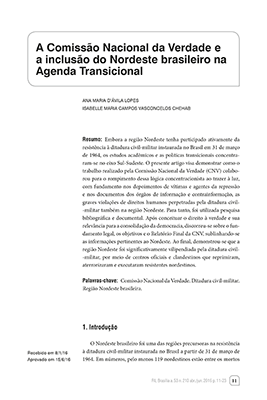Sub-representação política de mulheres: reflexões a respeito das eleições à vereança no Recôncavo da Bahia
Maria Inês Caetano Ferreira
DOI: https://doi.org/10.70015/ril_v58_n229_p79
Resumo
O artigo apresenta resultados de pesquisa sobre a participação de mulheres nas eleições para vereança no Recôncavo baiano, com o objetivo de compreender o fenômeno da sub-representação feminina na política. A literatura feminista que debate a desigualdade de gênero fundamentou a pesquisa. A metodologia adotada foi a análise de estatísticas eleitorais do Tribunal Superior Eleitoral, e as informações sobre candidatos foram sistematizadas de modo a distribuí-los em três grupos: menos votados, intermediários e mais votados. Os resultados revelam que as candidaturas masculinas se concentram no grupo intermediário, ao passo que as femininas estão no grupo dos menos votados, ratificando a sua sub-representação. No grupo dos mais votados destacam-se os homens. Na direção do debate teórico, os resultados indicam que a lei de cotas não favorece a vitória de candidaturas femininas e estimula o registro de candidaturas não engajadas na política. Em suma, os principais obstáculos à representação permanecem em vigor.
Palavras-chave
Gênero e política. Eleições municipais. Desigualdades de gênero.
Título, resumo e palavras-chave em inglês
Political under-representation of women: reflections about the municipal legislative branch in Recôncavo da Bahia
This article shows finding of research on the participation of women in the city councilor elections in the Recôncavo da Bahia in order to understand the phenomenon of female under-representation in politics. The feminist literature that debates gender inequality inspired the research. The methodology adopted was the analysis of electoral statistics of Tribunal Superior Eleitoral, and the candidate information has been systematized in order to distribute them in three groups: less voted, intermediate and most voted. The results reveal that male applications are concentrated in the middle group, while women, in the group with the least votes, confirming female under-representation. In the group with the most votes, men stand out. In the direction of the theoretical debate, the results indicate that the quota law does not favor the victory off female candidates and encourages the re-registration of candidates not engaged in politics. In short, the main obstacles to representation remain in force.
Gender and politics. Municipal elections. Gender inequalities. Electoral quotas.
Como citar este artigo
(ABNT)
FERREIRA, Maria Inês Caetano. Sub-representação política de mulheres: reflexões a respeito das eleições à vereança no Recôncavo da Bahia. Revista de Informação Legislativa: RIL, Brasília, DF, v. 58, n. 229, p. 79-101, jan./mar. 2021. Disponível em: https://www12.senado.leg.br/ril/edicoes/58/229/ril_v58_n229_p79
(APA)
Ferreira, M. I. C. (2021). Sub-representação política de mulheres: reflexões a respeito das eleições à vereança no Recôncavo da Bahia. Revista de Informação Legislativa: RIL, 58(229), 79-101. Recuperado de https://www12.senado.leg.br/ril/edicoes/58/229/ril_v58_n229_p79
